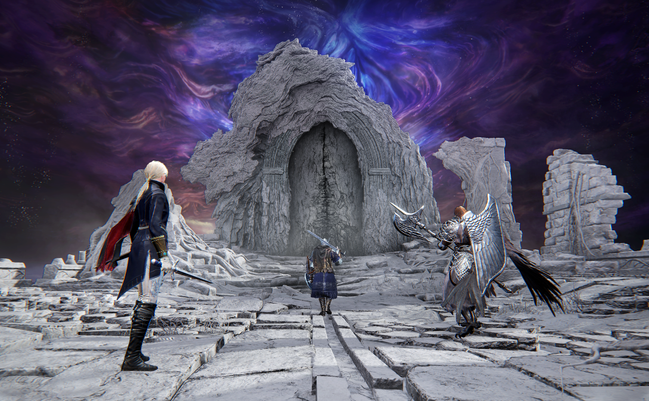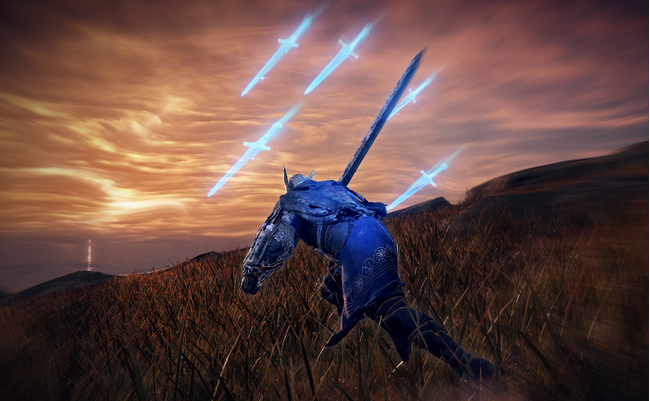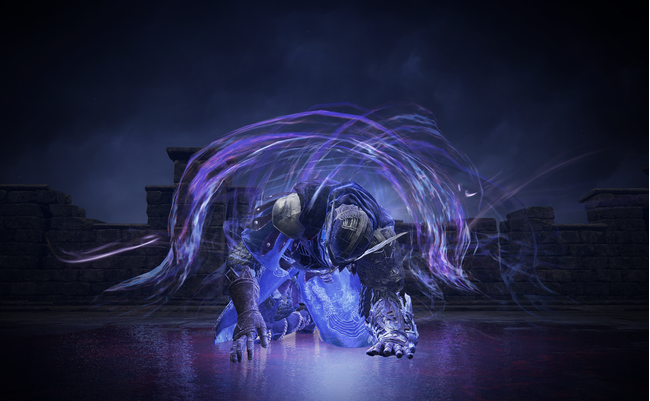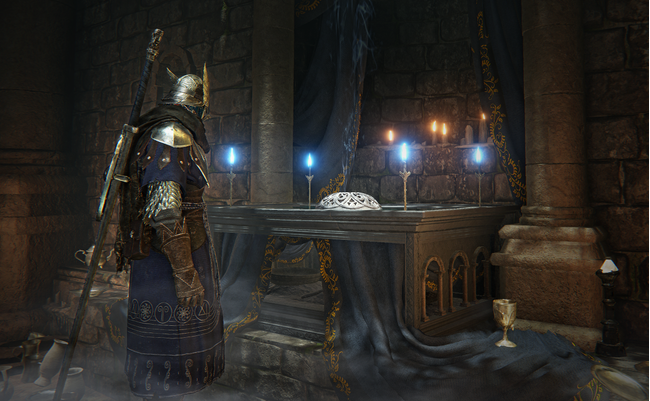
Elden Ring Nightreign is RPG character-building in a gloriously panicked fast-forward - hands-on
For my money, there are two core components to the DNA of a Souls game as defined by genre originators FromSoftware. First off there’s masochism - not just the difficulty, but the sheer emotion and dedication of throwing yourself at a difficult boss repeatedly. Then there’s the triumph of finally doing it, which often is accomplished through a combination of twitchy, sweat-breaking skill and thoughtful RPG character build composition.
The task facing Elden Ring Nightreign is simple, then: how do you transition those two components to a co-operative PVE multiplayer game - and cram that same emotional loop into multiplayer matches that last well under an hour? The answer, FromSoftware has determined, is all about Time Management.
Having now played the game for over six hours, I feel confident in saying that anyone who sums Elden Ring Nightreign up as being a bit like Fortnite is either clueless or pulling your leg. Fortnite’s influence is obvious - you ‘drop in’ to a circular map and a ring of fire closes in on you - but this is more than that. This is a roguelike. It’s got a little touch of The Legend of Zelda: Majora's Mask, of all things. And while streamlined, it remains an utterly committed role-playing game.
Let’s go through those references. Structurally, the game is indeed like a micro Majora’s Mask, featuring a three-day structure - but with a Souls twist. The ‘ring of fire’ that encloses you into an ever-smaller area of the map does so over the course of a day, meaning you can explore the map freely when you first start a run but increasingly lose that freedom. Once the sun sets, a major boss arrives. Defeat the boss to survive the night and you earn another day of exploration. If you survive an encounter with the night two boss, you’ll then face off against a final-final boss on the third and final day.

The timing structure helps to lend to one of those Souls tentpoles. You know that feeling you get when you get a really difficult boss you’ve died to some twenty times on the ropes? I felt that a whole lot playing Elden Ring Nightreign, except I felt it as the night was closing in and I knew a difficult boss encounter was coming but I didn’t quite know if my squad was truly ready. It’s a good-bad feeling. Your stomach turns. And then you throw yourself against that brick wall. That’s Souls, baby!
Then there’s those roguelike chops, which in truth are deeply tied to the role-playing credentials. Let’s get the difficult and potentially unpaletable admission out of the way up top: you lose pretty much everything from one run to the next. There’s a handful of buff items you can equip to each character, and a persistent currency that’s used to this end - but that’s it. The weapons you pick up and levels you gain disappear with each run. I know that might put some of you off.
But stay your hand from pressing the ‘close page’ button. The important thing to know is that this is not structurally anything like Elden Ring. For a start, it's utterly mile-a-minute. In a sense, it’s rather like playing a normal Souls game in fast forward. You’ll rack up your first five character levels in a matter of minutes. You build out a character build quickly, and it’ll ultimately end up discarded just as quickly. It’s in this madness, however, that the real joy of Nightreign resides.
When you drop into the new but familiar-feeling realm of Limveld, your job in the daytime is essentially to defeat sub-bosses and explore the map quickly and efficiently in order to rack up character levels and cobble together a character build in time for the nighttime boss battle. This is where time management comes into play: you really don’t have very long at all, so being decisive is vital and every decision is utterly crucial to survival. If you don’t survive, it’s game over, back to Roundtable Hold, and try again another run. Brutal.
The speedy nature of things means two things: for one, the sense of panicked momentum is constant. This might be my favorite thing about the game, even. I’m generally quite a solitary player. If I play online, it’s usually a solo competitive endeavor. When I was addicted to Halo, I always used to play Lone Wolves, or play Big Team Battle, a mode so large that you can sort of play relatively alone. I’m that archetypal guy on TV that growls, “I work alone” before being forced into teaming up. But in its preview sessions, Nightreign got me out of my shell - while collaboration is technically optional, your best chance of surviving means working out with your two teammates where you’re going, what you’re doing - and also sharing out the limited gear to ensure everyone has the best chance of properly contributing to the struggle against a boss.

More importantly, though, is that the speed has necessitated significant streamlining. All those gear slots you’re used to from Elden Ring are gone, for instance: each character now has eight weapon slots and two accessory slots. That sounds like a regression, and in a sense it is, but it’s balanced by accessories with more potent effects and a new weapon buff system, where passive buffs on each randomly-generated weapon that drops remains active as long as the weapon is in your possession - if you’re using it or not. Quite often I’d be holding on to a couple of weapons I had no intent on using at all just to enjoy their passive buffs, like a boost to attack power, survivability, or an elemental damage bonus.
Again, I emphasize how all of these decisions have to be made at speed. Plus as a true roguelike, all weapon drops are random. As you get to know each configuration of the map that you can get you’ll begin to get an idea of where to go to find squishier minibosses, specific upgrade materials, and so on. But the drops themselves are random - which obviously gives both the joy of an incredible drop and the dejection of one that isn’t to your favor. When that happens, you have to think fast and pivot. I can’t recall an RPG experience where I’ve had to pivot a planned character build and combat style quite as quickly as this. It’s thrilling.
Best of all, I think, is that thrill still hits those classic Soulsy beats. At one point I find myself finding a particular weapon in the earliest stages of a run and immediately announce to my squad of adventurers, “Okay, I’m now shooting for a bleed build.” A good drop comes and an instant decision is made - and then you have to keep moving, keep exploring, keep the momentum going, because the ring of fire is coming, closing in, bringing with it the night - and a boss. If the next drop is bad, maybe I'll change direction - or maybe I'll try to stick to my guns and make it work. When an entire match is only around 45 minutes or so - and it sure flies past fast - there's no time to dally.
The choices begin to compound as the time pressure mounts. Do we kill a boss for a chance at more gear? Do we storm a church and quickly grab an extra health-restoring flask? Do we duck underground to mine some upgrade materials and dash to a smithing spot to upgrade before nightfall? There isn't time for everything - you've got to decide, and fast. And if you disagree, does the party of three risk splitting up? Or does somebody have to compromise? Communication becomes key - preferably though voice but if not through dropping pins on the map. In a clever touch, each player has a color coordinated pin on the map - but if two players pin the same location, the pin changes colour and becomes prioritized to denote that it's an 'agreed' destination among a majority of the team.
One thing that requires less thought is the act of leveling up. In Nightreign, defeating enemies and bosses still grants runes but you now spend them quickly by hammering the OK button at a Site of Grace. You don’t need to select individual stats to level up - but that’s because you’re no longer playing a created character. Instead you are ‘impersonating’ (a curious lore-sensitive choice of words on the part of Bandai Namco representatives) one of a number of iconic heroes that fit into classical archetypes. When youn level up, your chosen character’s stats will scale as is appropriate for their character archetype.

In the hands-on we had four characters to choose from, though the final game will have multiples of that. They fit into basic archetypes, anyway:
- Wylder is the all-rounder, coming with a greatsword and small shield.
- Guardian is your classic tank, wielding a spear and a much larger shield.
- The Duchess is more like a thief - reminiscent, I suppose, of Elden Ring’s Black Knives.
- The Recluse gives Ranni vibes, and is the designated range magic mage.
These are just four characters, but all of the others will offer various permutations and twists on classic RPG setups and themes, and especially those you’d expect from Souls. As well as picking up weapons, each character has a unique ability and an ultimate ability that sort of defines their play-style.
Wylder has a grappling hook that lets him pull small enemies into his attack range or pull himself towards heftier foes. The thief-like Duchess has a quickstep to close gaps or get out of trouble. The Recluse has an intriguing must-master ability to create magic cocktails by drawing elemental magic essence from friends and foes alike - which is also the only reliable way to restore FP, giving the character a rhythmic dance of casting normal spells and crafting magic cocktails to restore the mana needed to cast more. Some of the character abilities will lean into specific system mechanics, too, such as the Recluse having a 'magic cocktail' ability that lets you mix and match different elemental properties to create powerful magic attacks. The Guardian’s ultimate is a total game changer of an attack, able to devastate enemies and revive down-but-not-out allies with ease.
You can sense how all of this adds up, can’t you? I’m one of those RPG sickos that really gets a kick out of crunchy systems and in-depth mechanics. I like to watch the numbers go up. This isn’t quite that… this is something new, concocted by putting together a strange mix of the familiar elements of Souls games with concepts from other genres. But as well as feeling new, it’s also very compelling indeed. It gets across the same feelings, the same emotions, the same vibe as Elden Ring at its best - but in a very different way, and in a very different format.
A lot of it comes down to time management, like I said. The sense of panic as that ring of fire closes in is palpable. Never in an Elden Ring would you have to think of abandoning a half-finished boss fight in order to save yourself from the world itself - but here you can. You must, sometimes. But the world has memory; if you survive the night, you can come back the next day to finish off your weakened foe. If that’s worth it is just one of the consequential decisions you’ll have to make along the way.

The foundation is strong, then. Questions remain with a game like this, of course. It’s new territory for FromSoftware and Souls fans alike; there’s certainly a question of content, and what might be coming in post-launch support to keep people wanting to play over a long time - which is the lifeblood of any multiplayer game of this type. And I’m curious about the extent of repackaged content from past games, because while the mechanics are all-fresh, this is a game built largely out of existing component parts borrowed from Elden Ring and even other Dark Souls games. That’s okay - content reuse is not inherently bad - but that recycling has to be judged on an axis where the value of the game and total extent of the content is also considered.
Then there’s the nuts and bolts: how well servers will hold up, how useful the limited progression that you can carry from one run to the next actually is, if matchmaking works well, and even how competent and fun the solo play option is (you can play alone, or with three humans - there are no AI allies). These things can only be truly judged with the final game in hand. At preview, one’s critical eye instead turns to the foundation, and on this website, the most important of those is the game’s character as an RPG.
And crikey, that foundation. It’s good. I loved how in every single run I played I was putting together wildly different character builds, even when playing the same character repeatedly. The universe provides to you, and where Souls is typically about carefully crafting the perfect build, this is a scrappier and more immediate representation of that same concept.
Six hours of Elden Ring Nightreign and I felt utterly hooked; I started thinking about which friends I most wanted to recruit to my squad of three. I started to think about the different ways the map, and its not-totally-random setup could be manipulated with the right angle of attack and right order of places to visit.
When my mind is racing like this, when the game is still in my head several days after the preview event is over… I know there’s something there that really excites. Such is the case with Nightreign. We’ll find out exactly how that enormous potential pans out in a full release on May 30th, when it arrives for PC, PS5, and Xbox Series consoles.



